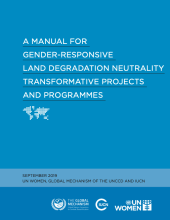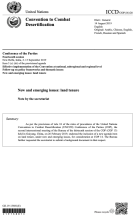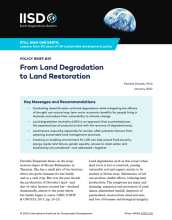/ library resources
Showing items 4591 through 4599 of 4615.The semi-arid grasslands in Inner Mongolia, China have been degraded by long-term grazing. A series of ecological restoration strategies have been implemented to improve grassland service.
Obtaining information about soil properties under different agricultural uses to plan soil management is very important with a view to sustainability in the different agricultural systems.
Climate- and human-induced land degradation endangers the future survival of our planet. A new focus on achieving Land Degradation Neutrality (LDN) seeks to spark and grow transformative efforts to avoid, reduce and reverse land degradation through gender- and socially-equitable means.
As per the provisions of rule 10 of the rules of procedures of the United Nations Convention to Combat Desertification (UNCCD) Conference of the Parties (COP), the second intersessional meeting of the Bureau of the thirteenth session of the COP (COP 13) held in Guiyang, China, on 26 February 2019
UNCCD Decision 26 / COP.14 Land tenure
Key Messages and Recommendations
• Combating desertification and land degradation while mitigating the effects of drought can secure long-term socio-economic benefits for people living in drylands and reduce their vulnerability to climate change.
The relationship between livestock production and climate change is the subject of hot debate, with arguments for major shifts in diets and a reduction in livestockproduction.
Urgent climate challenges have triggered calls for radical, widespread changes in what we eat, pushing for the drastic reduction if not elimination of animal-source foods from our diets.
Paginación
Land Library Search
Through our robust search engine, you can search for any item of the over 73,000 highly curated resources in the Land Library.
If you would like to find an overview of what is possible, feel free to peruse the Search Guide.





